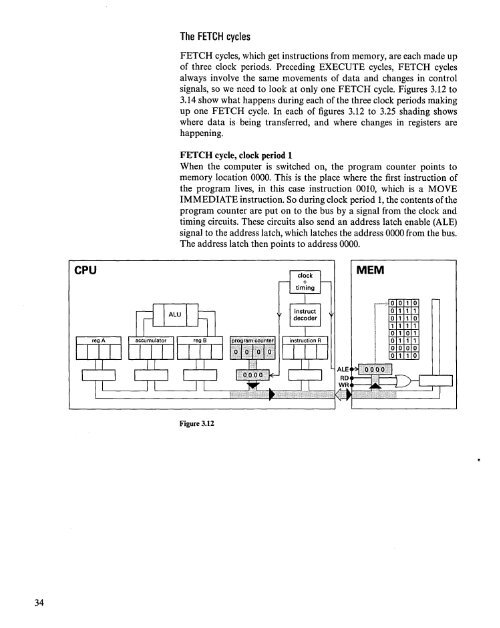Microcomputer Circuits and Processes
Microcomputer Circuits and Processes
Microcomputer Circuits and Processes
You also want an ePaper? Increase the reach of your titles
YUMPU automatically turns print PDFs into web optimized ePapers that Google loves.
The FETCH cycles<br />
FETCH cycles, which get instructions from memory, are each made up<br />
of three clock periods. Preceding EXECUTE cycles, FETCH cycles<br />
always involve the same movements of data <strong>and</strong> changes in control<br />
signals, so we need to look at only one FETCH cycle. Figures 3.12 to<br />
3.14 show what happens during each of the three clock periods making<br />
up one FETCH cycle. In each of figures 3.12 to 3.25 shading shows<br />
where data is being transferred, <strong>and</strong> where changes in registers are<br />
happening.<br />
FETCH cycle, clock period 1<br />
When the computer is switched on, the program counter points to<br />
memory location 0000. This is the place where the first instruction of<br />
the program lives, in this case instruction 0010, which is a MOVE<br />
IMMEDIATE instruction. So during clock period 1,the contents of the<br />
program counter are put on to the bus by a signal from the clock <strong>and</strong><br />
timing circuits. These circuits also send an address latch enable (ALE)<br />
signal to the address latch, which latches the address 0000 from the bus.<br />
The address latch then points to address 0000.<br />
CPU<br />
MEM<br />
, 0 0 1 0<br />
o 1 1 1<br />
o 1 1 0<br />
1 1 1 1<br />
o 1 0 1<br />
o 1 1 1<br />
o 0 0 0<br />
o 1 1 0<br />
Figure 3.12<br />
34











